过去分词的用法详解
- 格式:doc
- 大小:22.00 KB
- 文档页数:4
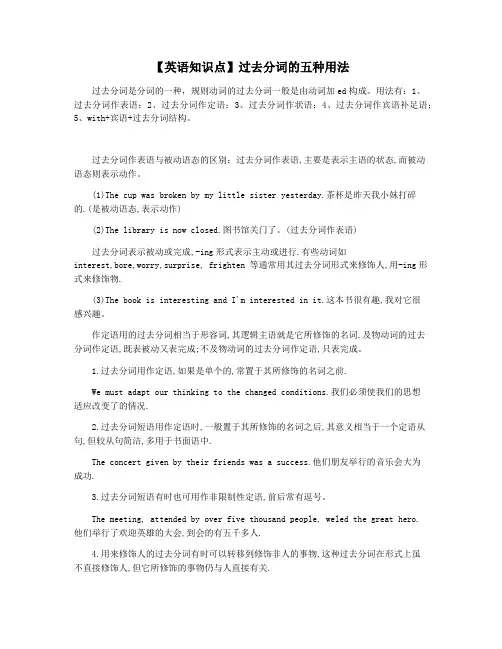
【英语知识点】过去分词的五种用法过去分词是分词的一种,规则动词的过去分词一般是由动词加ed构成。
用法有:1、过去分词作表语;2、过去分词作定语;3、过去分词作状语;4、过去分词作宾语补足语;5、with+宾语+过去分词结构。
过去分词作表语与被动语态的区别:过去分词作表语,主要是表示主语的状态,而被动语态则表示动作。
(1)The cup was broken by my little sister yesterday.茶杯是昨天我小妹打碎的.(是被动语态,表示动作)(2)The library is now closed.图书馆关门了。
(过去分词作表语)过去分词表示被动或完成,-ing形式表示主动或进行.有些动词如interest,bore,worry,surprise, frighten 等通常用其过去分词形式来修饰人,用-ing形式来修饰物.(3)The book is interesting and I'm interested in it.这本书很有趣,我对它很感兴趣。
作定语用的过去分词相当于形容词,其逻辑主语就是它所修饰的名词.及物动词的过去分词作定语,既表被动又表完成;不及物动词的过去分词作定语,只表完成。
1.过去分词用作定语,如果是单个的,常置于其所修饰的名词之前.We must adapt our thinking to the changed conditions.我们必须使我们的思想适应改变了的情况.2.过去分词短语用作定语时,一般置于其所修饰的名词之后,其意义相当于一个定语从句,但较从句简洁,多用于书面语中.The concert given by their friends was a success.他们朋友举行的音乐会大为成功.3.过去分词短语有时也可用作非限制性定语,前后常有逗号。
The meeting, attended by over five thousand people, weled the great hero.他们举行了欢迎英雄的大会,到会的有五千多人.4.用来修饰人的过去分词有时可以转移到修饰非人的事物,这种过去分词在形式上虽不直接修饰人,但它所修饰的事物仍与人直接有关.The boy looked up with a pleased expression.男孩带着满意的表情举目而视。
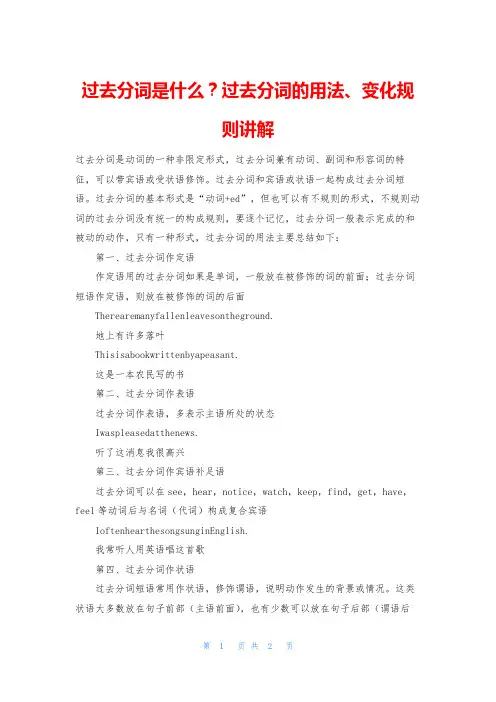
过去分词是什么?过去分词的用法、变化规则讲解过去分词是动词的一种非限定形式,过去分词兼有动词、副词和形容词的特征,可以带宾语或受状语修饰。
过去分词和宾语或状语一起构成过去分词短语。
过去分词的基本形式是“动词+ed”,但也可以有不规则的形式,不规则动词的过去分词没有统一的构成规则,要逐个记忆,过去分词一般表示完成的和被动的动作,只有一种形式,过去分词的用法主要总结如下:第一、过去分词作定语作定语用的过去分词如果是单词,一般放在被修饰的词的前面;过去分词短语作定语,则放在被修饰的词的后面Therearemanyfallenleavesontheground.地上有许多落叶Thisisabookwrittenbyapeasant.这是一本农民写的书第二、过去分词作表语过去分词作表语,多表示主语所处的状态Iwaspleasedatthenews.听了这消息我很高兴第三、过去分词作宾语补足语过去分词可以在see,hear,notice,watch,keep,find,get,have,feel等动词后与名词(代词)构成复合宾语IoftenhearthesongsunginEnglish.我常听人用英语唱这首歌第四、过去分词作状语过去分词短语常用作状语,修饰谓语,说明动作发生的背景或情况。
这类状语大多数放在句子前部(主语前面),也有少数可以放在句子后部(谓语后面),或者插在中间(主语后面)Theprofessorcamein,followedbyagroupofyoungpeople.教授走进来,后面跟着一群年轻人1、表原因,相当于一个原因状语从句Thechildrensoonfeelasleep,exhaustedbythejourney.由于旅途劳累,孩子们很快就睡着了2、表时间,相当于一个时间状语从句Seenfromthehill,theparklooksverybeautiful.从山上看这个公园非常漂亮3、假设的情况,相当于一个条件状语从句Givenmoretime,wecoulddoitmuchbetter.多给点时间,我们会做得更好些4、表让步,相当于一个让步状语从句Beatenbytheoppositeteam,theplayerswerenotdiscouragedandpractisedevenharder.虽然被对方打败,但队员们没有泄气,更加刻苦训练5、表伴随情况,这种用法没有与之相当的状语从句可以代替Hecameback,utterlyexhausted.他回来时,疲惫不堪相关推荐过去分词是动词的一种非限定形式,过去分词兼有动词、副词和形容词的特征,可以带宾语或受状语修饰。

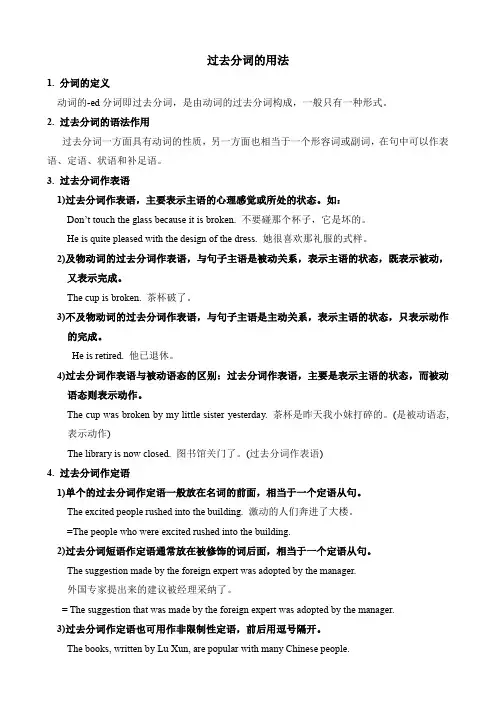
过去分词的用法1. 分词的定义动词的-ed分词即过去分词,是由动词的过去分词构成,一般只有一种形式。
2. 过去分词的语法作用过去分词一方面具有动词的性质,另一方面也相当于一个形容词或副词,在句中可以作表语、定语、状语和补足语。
3. 过去分词作表语1)过去分词作表语,主要表示主语的心理感觉或所处的状态。
如:Don’t touch the glass because it is broken. 不要碰那个杯子,它是坏的。
He is quite pleased with the design of the dress. 她很喜欢那礼服的式样。
2)及物动词的过去分词作表语,与句子主语是被动关系,表示主语的状态,既表示被动,又表示完成。
The cup is broken. 茶杯破了。
3)不及物动词的过去分词作表语,与句子主语是主动关系,表示主语的状态,只表示动作的完成。
He is retired. 他已退休。
4)过去分词作表语与被动语态的区别:过去分词作表语,主要是表示主语的状态,而被动语态则表示动作。
The cup was broken by my little sister yesterday. 茶杯是昨天我小妹打碎的。
(是被动语态,表示动作)The library is now closed. 图书馆关门了。
(过去分词作表语)4. 过去分词作定语1)单个的过去分词作定语一般放在名词的前面,相当于一个定语从句。
The excited people rushed into the building. 激动的人们奔进了大楼。
=The people who were excited rushed into the building.2)过去分词短语作定语通常放在被修饰的词后面,相当于一个定语从句。
The suggestion made by the foreign expert was adopted by the manager.外国专家提出来的建议被经理采纳了。
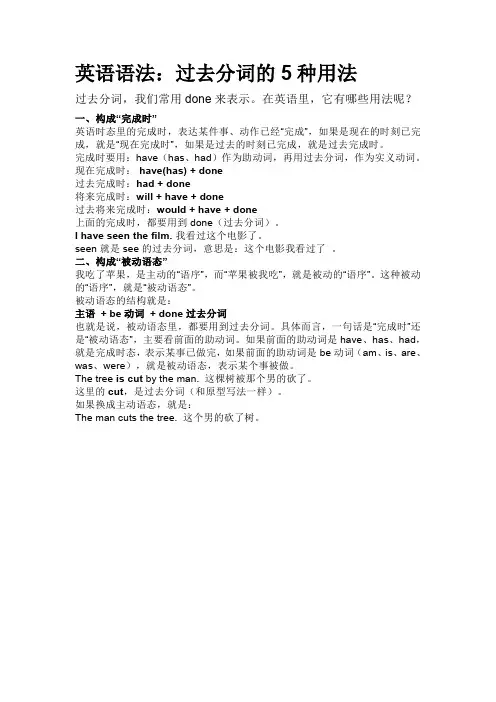
英语语法:过去分词的5种用法
过去分词,我们常用done来表示。
在英语里,它有哪些用法呢?
一、构成“完成时”
英语时态里的完成时,表达某件事、动作已经“完成”,如果是现在的时刻已完成,就是“现在完成时”,如果是过去的时刻已完成,就是过去完成时。
完成时要用:have(has、had)作为助动词,再用过去分词,作为实义动词。
现在完成时:have(has) + done
过去完成时:had + done
将来完成时:will + have + done
过去将来完成时:would + have + done
上面的完成时,都要用到done(过去分词)。
I have seen the film.我看过这个电影了。
seen就是see的过去分词,意思是:这个电影我看过了。
二、构成“被动语态”
我吃了苹果,是主动的“语序”,而“苹果被我吃”,就是被动的“语序”。
这种被动的“语序”,就是“被动语态”。
被动语态的结构就是:
主语+ be动词+ done过去分词
也就是说,被动语态里,都要用到过去分词。
具体而言,一句话是“完成时”还是“被动语态”,主要看前面的助动词。
如果前面的助动词是have、has、had,就是完成时态,表示某事已做完,如果前面的助动词是be动词(am、is、are、was、were),就是被动语态,表示某个事被做。
The tree is cut by the man. 这棵树被那个男的砍了。
这里的cut,是过去分词(和原型写法一样)。
如果换成主动语态,就是:
The man cuts the tree. 这个男的砍了树。
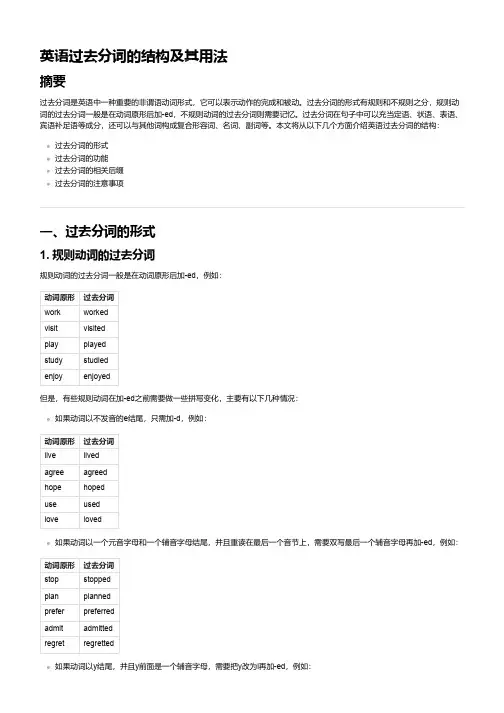
英语过去分词的结构及其用法摘要过去分词是英语中一种重要的非谓语动词形式,它可以表示动作的完成和被动。
过去分词的形式有规则和不规则之分,规则动词的过去分词一般是在动词原形后加-ed,不规则动词的过去分词则需要记忆。
过去分词在句子中可以充当定语、状语、表语、宾语补足语等成分,还可以与其他词构成复合形容词、名词、副词等。
本文将从以下几个方面介绍英语过去分词的结构:过去分词的形式过去分词的功能过去分词的相关后缀过去分词的注意事项一、过去分词的形式1. 规则动词的过去分词规则动词的过去分词一般是在动词原形后加-ed,例如:动词原形过去分词work workedvisit visitedplay playedstudy studiedenjoy enjoyed但是,有些规则动词在加-ed之前需要做一些拼写变化,主要有以下几种情况:如果动词以不发音的e结尾,只需加-d,例如:动词原形过去分词live livedagree agreedhope hopeduse usedlove loved如果动词以一个元音字母和一个辅音字母结尾,并且重读在最后一个音节上,需要双写最后一个辅音字母再加-ed,例如:动词原形过去分词stop stoppedplan plannedprefer preferredadmit admittedregret regretted如果动词以y结尾,并且y前面是一个辅音字母,需要把y改为i再加-ed,例如:动词原形过去分词study studiedcry criedtry triedcarry carriedworry worried2. 不规则动词的过去分词不规则动词的过去分词没有固定的规则,需要通过记忆来掌握。
不规则动词的过去分词可以根据其与原形和过去式之间的关系,大致分为以下几类:原形、过去式和过去分词完全相同,例如:动词原形过去式过去分词cut cut cuthit hit hitput put putread read readhurt hurt hurt原形和过去式相同,而过去分词不同,例如:动词原形过去式过去分词come come comebecome become becomerun run runwin win wonswim swim swum原形和过去分词相同,而过去式不同,例如:动词原形过去式过去分词build built builtburn burnt burntdream dreamt dreamtlearn learnt learntspoil spoilt spoilt原形、过去式和过去分词都不相同,例如:动词原形过去式过去分词be was/were beendo did donego went gonesee saw seenwrite wrote written原形和过去分词以n结尾,而过去式以w结尾,例如:动词原形过去式过去分词know knew knowngrow grew grownblow blew blownfly flew flowndraw drew drawn原形和过去分词以d结尾,而过去式以t结尾,例如:动词原形过去式过去分词build built builtlend lent lentsend sent sentspend spent spent原形和过去分词以e结尾,而过去式以a或o结尾,例如:动词原形过去式过去分词give gave giventake took takenmake made madebreak broke brokenspeak spoke spoken原形和过去分词以t结尾,而过去式以a结尾,例如:动词原形过去式过去分词teach taught taughtcatch caught caughtbuy bought boughtbring brought broughtthink thought thought原形和过去分词以n结尾,而过去式以a结尾,例如:动词原形过去式过去分词begin began begundrink drank drunksing sang sungring rang rungswim swam swum二、过去分词的功能过去分词在句子中可以充当多种成分,主要有以下几种功能:1. 构成被动语态过去分词可以与助动词be或get构成被动语态,表示主语是动作的承受者,而不是执行者。
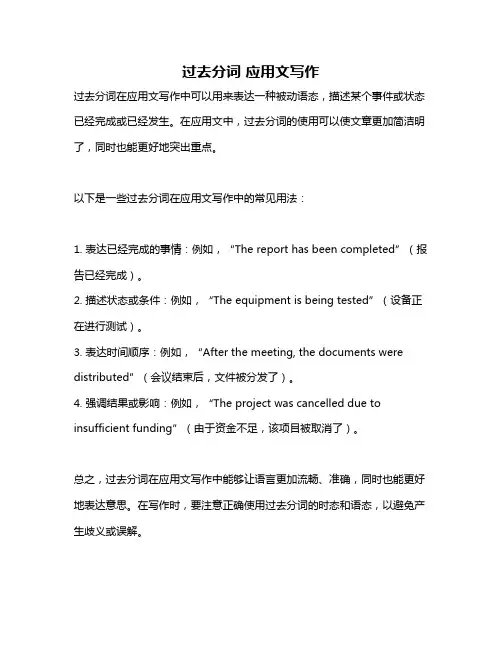
过去分词应用文写作
过去分词在应用文写作中可以用来表达一种被动语态,描述某个事件或状态已经完成或已经发生。
在应用文中,过去分词的使用可以使文章更加简洁明了,同时也能更好地突出重点。
以下是一些过去分词在应用文写作中的常见用法:
1. 表达已经完成的事情:例如,“The report has been completed”(报告已经完成)。
2. 描述状态或条件:例如,“The equipment is being tested”(设备正在进行测试)。
3. 表达时间顺序:例如,“After the meeting, the documents were distributed”(会议结束后,文件被分发了)。
4. 强调结果或影响:例如,“The project was cancelled due to insufficient funding”(由于资金不足,该项目被取消了)。
总之,过去分词在应用文写作中能够让语言更加流畅、准确,同时也能更好地表达意思。
在写作时,要注意正确使用过去分词的时态和语态,以避免产生歧义或误解。
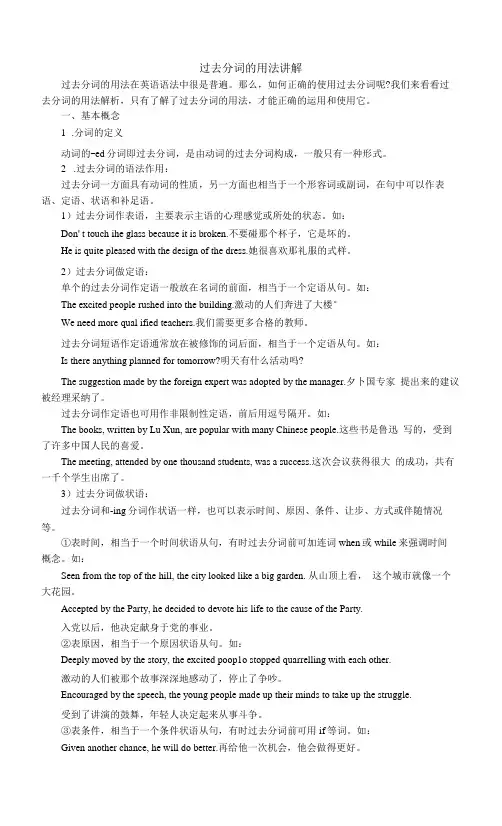
过去分词的用法讲解过去分词的用法在英语语法中很是普遍。
那么,如何正确的使用过去分词呢?我们来看看过去分词的用法解析,只有了解了过去分词的用法,才能正确的运用和使用它。
一、基本概念1.分词的定义动词的-ed分词即过去分词,是由动词的过去分词构成,一般只有一种形式。
2.过去分词的语法作用:过去分词一方面具有动词的性质,另一方面也相当于一个形容词或副词,在句中可以作表语、定语、状语和补足语。
1)过去分词作表语,主要表示主语的心理感觉或所处的状态。
如:Don' t touch ihe glass because it is broken.不要碰那个杯子,它是坏的。
He is quite pleased with the design of the dress.她很喜欢那礼服的式样。
2)过去分词做定语:单个的过去分词作定语一般放在名词的前面,相当于一个定语从句。
如:The excited people rushed into the building.激动的人们奔进了大楼°We need more qual ified teachers.我们需要更多合格的教师。
过去分词短语作定语通常放在被修饰的词后面,相当于一个定语从句。
如:Is there anything planned for tomorrow?明天有什么活动吗?The suggestion made by the foreign expert was adopted by the manager.夕卜国专家提出来的建议被经理采纳了。
过去分词作定语也可用作非限制性定语,前后用逗号隔开。
如:The books, written by Lu Xun, are popular with many Chinese people.这些书是鲁迅写的,受到了许多中国人民的喜爱。
The meeting, attended by one thousand students, was a success.这次会议获得很大的成功,共有一千个学生出席了。
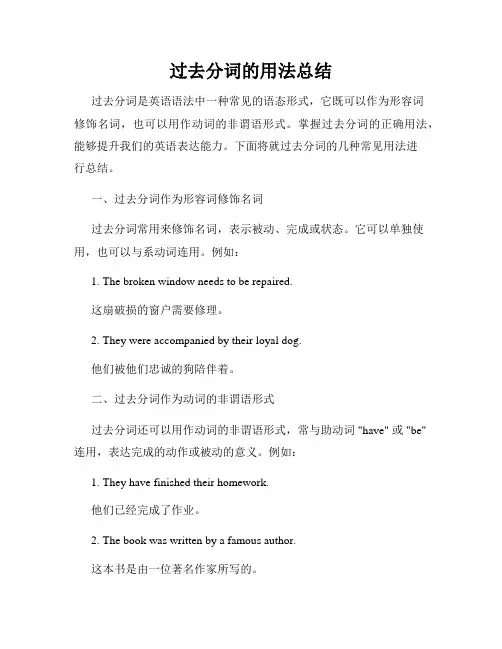
过去分词的用法总结过去分词是英语语法中一种常见的语态形式,它既可以作为形容词修饰名词,也可以用作动词的非谓语形式。
掌握过去分词的正确用法,能够提升我们的英语表达能力。
下面将就过去分词的几种常见用法进行总结。
一、过去分词作为形容词修饰名词过去分词常用来修饰名词,表示被动、完成或状态。
它可以单独使用,也可以与系动词连用。
例如:1. The broken window needs to be repaired.这扇破损的窗户需要修理。
2. They were accompanied by their loyal dog.他们被他们忠诚的狗陪伴着。
二、过去分词作为动词的非谓语形式过去分词还可以用作动词的非谓语形式,常与助动词 "have" 或 "be" 连用,表达完成的动作或被动的意义。
例如:1. They have finished their homework.他们已经完成了作业。
2. The book was written by a famous author.这本书是由一位著名作家所写的。
三、过去分词表示原因或原因结果关系过去分词还可以用来表示某种情况或行为的原因或结果。
例如:1. The heavy rain caused the streets to flood.大雨导致了街道的积水。
2. I was exhausted from working all day.我因为整天工作而筋疲力尽。
四、过去分词与时间、情感的关系过去分词也可以表示某种情感或状态。
例如:1. She was pleased with the results of the exam.她对考试的结果感到满意。
2. We were surprised by their sudden departure.他们突然离开让我们感到惊讶。
总结来说,过去分词在英语语法中具有广泛的应用。
它可以作为名词的修饰语、动词的非谓语形式,表示被动、完成或状态。

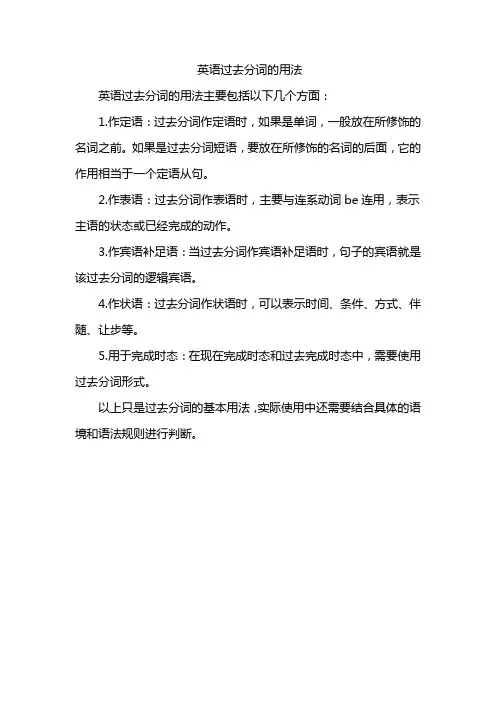
英语过去分词的用法
英语过去分词的用法主要包括以下几个方面:
1.作定语:过去分词作定语时,如果是单词,一般放在所修饰的名词之前。
如果是过去分词短语,要放在所修饰的名词的后面,它的作用相当于一个定语从句。
2.作表语:过去分词作表语时,主要与连系动词be连用,表示主语的状态或已经完成的动作。
3.作宾语补足语:当过去分词作宾语补足语时,句子的宾语就是该过去分词的逻辑宾语。
4.作状语:过去分词作状语时,可以表示时间、条件、方式、伴随、让步等。
5.用于完成时态:在现在完成时态和过去完成时态中,需要使用过去分词形式。
以上只是过去分词的基本用法,实际使用中还需要结合具体的语境和语法规则进行判断。
过去分词的用法第一,掌握过去分词的形式,动词原形do变成done;第二,过去分词和现在分词一样,具有形容词或副词功能,在句中一般充当定语和状语;第三,过去分词一般表示与其被修饰词之间是“被动”的关系,且强调动作为“已经完成了的”。
英语当中,过去分词它的变化形式叫做done,也就是说一个动词,原形、过去式、过去分词,我们按照公式来看的话,就是do、did和done,那么done就叫过去分词,我们通常按照动词的规则变化以及不规则变化,我们可以看到很多动词都有它的过去分词的形式,好比说look,它的过去分词也就是done的形式,那就叫looked。
see它的过去分词的形式叫做seen,be动词它的过去分词叫做been。
我们知道了done的形式,关于它的用法,这里我们说一下,过去分词最常用的就是做定语和做状语,那么做定语和做状语,不管他做什么,他都表达两层意思,请各位注意,过去分词在做定语和状语的时候,都同时表达两层意思,分别是过去和被动。
什么叫做同时表达过去和被动?举个例子。
I have read a book written by Charles Dickens。
我读了一本由查尔斯狄更斯写的书,I have read a book written by Charles Dickens。
这里written就是write,表示写文章的“写”的过去分词,它做定语修饰前面的book书,这个时候我们看一下“书”和“写”是被写,书和写就是过去已经写。
换句话说,这个句子想表达的就是这个书是在过去已经由查尔斯狄更斯写的书,这个时候我们再体会一下。
I have read a book written by Charles Dickens。
我们可以看到written作定语表达两层意思,和book之间是被动,和book之间是过去,这就是它做定语的用法。
做状语也是一样,比如说Seen from the distance,the house looked deserted。
过去分词的用法一、过去分词作定语用法〔Past Participles Used as Attributes〕过去分词作定语,在语态上,表被动;在时间上,表示动作已经发生或完成,与它所修饰的名词有逻辑〔意义〕上的动宾关系。
过去分词作定语表示动作在谓语动作之前发生,已经完成并具有被动意义。
有时也不表示时间性。
作定语的过去分词一般由及物动词变来,因为只有及物动词才有被动意义。
He is a teacher loved by his students.也有用不及物动词的过去分词作定语的情况,一般作前置定语,它不表示被动意义,只表示主动意义,强调动作完成。
不能像及物动词的过去分词那样放在名词后面作定语。
例如:Fallen leaves retired workers the risen sun注意一下几点:1. 单个的过去分词作定语一般放在被修饰的名词之前。
例如:We needed much more qualified workers. My friend is a returned student. 单个分词也可以作后置定语,用以强调动作。
They decided to change the material used.2. 过去分词短语作定语要放在被修饰的名词后面,作后置定语,其作用相当于一个定语从句。
The student dressed in white is my daughter.=The student who is dressed in white is my daughter.)3. 如果被修饰的词是由every/some/any/no + thing/body/one所构成的复合代词或指示代词those等时,即使一个单一的分词做定语,也要放在被修饰词的后面。
Is there anything unsolved?There is noting changed here since I left this town.4. 单个过去分词前加一名词或副词,常用连字符将它们连接起来构成一个复合形容词,放在其修饰的名词前,作前置定语。
重点语法:一、过去分词作表语:1、过去分词作表语并无完成或被动之意,而是表示主语状态或思想感情等。
例句:No wonder he is excited!He looked worried after reading the letter.When we heard of it, we were deeply moved.He seemed quite delighted at the idea.2、可以用作表语的常见的过去分词有:amused 愉快的 connected 连接的 broken 碎了的 closed 关闭的completed 完成的 astonished 吃惊的 covered 覆盖的 crowded 拥挤的delighted 高兴的 disappointed失望的 dressed 穿着的 drunk 喝醉的experienced 有经验的 gone 遗失的 lost 丢失的 worried 担忧的interested 有兴趣的 tired 劳累的 pleased 高兴的 satisfied 满意的surprised 吃惊的 married 已婚的 known 著名的例句:The children are really excited about going to the zoo.孩子们对去动物园都很兴奋。
(表示一种感受)His wound became infected with a new virus.他的伤口感染了一种新的病毒。
(表示一种状态)3、注意区分过去分词作表语和被动语态分词作表语表示主语的状态,被动语态则表示被动的动作。
例:My glasses are broken.My glasses are broken by my son.On the earth, 70% of the surface is covered with water.I was greatly surprised by the knock at the door.二、过去分词作定语:done作定语时,其语法功能相当于一个定语从句。
过去分词表状态的用法小结
过去分词表示做完或被做的动作已完成,或者所描述的状态已经达成。
在句中常作谓语的补语,也可以用作形容词修饰名词或代替从句中的主语或宾语。
以下是过去分词的几种常见用法:
1. 作为谓语的补语:表示主语已经被动作所影响,并处于某种状态之中
例如:The window is broken. (窗户已经被打碎了)
2. 作为形容词修饰名词:表示名词所处的状态
例如:tired (疲惫的)、excited (兴奋的)、interested (感兴趣的)等
3. 作为过去分词短语修饰名词:表示名词的状态或情况
例如:a written agreement (一份书面协议)、a closed door (一扇关上的门)
4. 作为代替从句中的主语或宾语
例如:Thinking too much can cause problems.(想太多会造成问题)(thinking表示“想”这个动作的完成)
5. 作为被动语态的形式
例如:The book was written by John.(这本书是由约翰写的)。
过去分词的用法一、构成:规则动词的过去分词是有动词原形+ed构成的,不规则动词则有各自构成。
二、基本特点:过去分词在句子中的基本用法有两点:1.与逻辑主语之间是被动关系2.表示完成的动作三、过去分词的用法:1.作表语:过去分词作表语时,一般同时具备被动与完成的含义例如:(1)The cup isbroken. (2)He isretired. (3)After running,he istired.【注意】过去分词作表语时,已经变成形容词性质,主要表示主语的状态(被动完成),而被动语态则表示动作.例如:(1) The cupwas brokenby my little sister yesterday.茶杯是昨天我小妹打碎的.(是被动语态,表示动作)(2)The cup is nowbroken.茶杯碎了.(过去分词作表语,表示状态)【注意】有些动词如interest, bore, worry, surprise, frighten等通常用其过去分词形式来修饰人,表示''感到……〃用-ing形式来修饰物,表示〃令人……〃例如:The book isinterestingand I'minterestedin it.这本书很有趣,我对它很感兴趣.2.做定语作定语用的过去分词其逻辑主语就是它所修饰的名词.及物动词的过去分词作定语,既表被动又表完成;不及物动词的过去分词作定语,只表完成.1)单一过去分词作定语,常置于其所修饰的名词之前,称作前置定语。
例如:We must adapt our thinking to thechangedconditions.我们必须使我们的思想适应改变了的情况.2)过去分词短语用作定语时,一般置于其所修饰的名词之后,相当于一个定语从句,称作后置定语。
1 /11例如:The concertgiven by their friendswas a success.他们朋友举行的音乐会大为成功.3)过去分词短语有时也可用作非限制性定语,前后常有逗号.例如:The meeting,attended by over five thousand people, welcomed the great hero.4)用来修饰人的过去分词有时可以修饰与人有关的表情,面貌,举止行为以及感觉等,这时不能用v-ing形式例如:The boy looked up with apleasedexpression.Hissatisfiedlook showed that he had passed this exam.3.作状语作状语的过去分词在句子中多表示被动和完成两重含义。
过去分词的用法详解1. 分词作定语1)分词作定语既可以放在所修饰的词之前,作前置定语,也可以放在所修饰的词后面,作后置定语。
其作用相当于一个定语从句。
例如:Where are the reserved seats? (=Where are the seats which have been reserved?)预定的座位在哪里?This is a pressing problem. (=This is a problem which is pressing.)这是一个紧迫的问题。
2)分词作后置定语可分为限制性(紧跟在所修饰的中心词之后)和非限制性(用逗号与其所修饰的中心词分开)两种,其作用分别相当于一个限制性定语从句和非限制性定语从句。
例如:The funds raised (= which have been raised)are mainly used for helping the homeless.筹集的资金主要用来帮助那些无家可归的人。
There are many students waiting (= who are waiting)to get examined.有许多学生在等待检查。
This book,written (= which is written)in simple English,is suitable for beginners.本书是用浅显的英语写的,适合初学者。
3)分词常和形容词、副词或名词构成合成形容词作定语。
例如:The flower-carrying girl must be waiting for someone.那位手持鲜花的姑娘一定在等人。
The newly-built building is our office building.这座新建的大楼是我们的办公楼。
4)有些不及物动词的过去分词作定语,并不表示被动的意思而是表示完成。
这类过去分词常作前置修饰语。
例如:There are a lot of fallen leaves in autumn.秋天有许多落叶。
The film describes the story about the police who pursue an escaped man.这部电影描述的是警察抓逃犯的事。
常用的这一类词有:fallen,faded,returned,retired,risen,grown up,vanished 等。
2. 分词作宾语补足语1)跟分词作宾补的动词有:catch,have get,keep,hear,find,feel,leave,make,want,start,notice,observe,watch,set等。
例如:When they returned home from the holiday,they found their house stolen.当他们度假完回到家时,发现房子被盗了。
(过去分词表示被动)We want this work finished quickly.我们要求这项工作很快完成。
2)在复合宾语中,用现在分词作宾补,说明宾语是动作的发出者,形成逻辑上的主谓关系;用过去分词作宾补,表示宾语是动作的承受者,构成逻辑上的动宾关系。
例如:There was so much noise that the speaker couldn't make himself heard.由于十分吵闹,讲话人没法让人听到他的声音。
When he awoke,he found himself being looked after by an old woman.他醒来的时候发现一位老大娘正在照顾他。
3. 分词作状语1)分词或分词短语作状语时,可以表示时间、原因、让步、条件、方式或伴随状况。
通常可转换成相应的状语从句;表示方式或伴随状况的可以转换成并列句或非限制性定语从句。
例如:Confined to bed (= Because she was confined to bed),she needed to be waited on in everything.她卧病在床,什么事都需要人伺候。
(作原因状语)Having only book knowledge (= If you only have book knowledge),you will not be able to work well.如果只有书本知识,你就不可能做好工作。
(作条件状语)They stood there waiting for the bus. (=They stood there and waited for the bus.)他们站在那里等公共汽车。
(作方式状语)2)现在分词和过去分词作状语时的用法比较不管是现在分词还是过去分词作状语,如果单独作状语,其逻辑主语必须和主句的主语一致。
分词作状语通常可以转换成一个相应的状语从句,如果状语从句中的谓语动词为被动结构,就用过去分词;如果状语从句中的谓语动词为主动结构,就用现在分词。
有时为了强调,分词前可带连词when,while,if,though,as if,unless等一起作状语,以便使句子的意思更清楚、更连贯。
例如:Working hard (If you work hard),you will succeed.如果你努力,你会成功的。
Defeated (= Though he was defeated),he remained a popular boxer.虽然他被击败了,但他仍然是一个受人喜爱的拳击手。
4. 分词的独立结构1)分词作状语时,要特别注意其逻辑主语必须和谓语动词的主语一致。
否则,分词必须有自己的主语,这种带主语的分词被称为分词的独立结构,或叫独立主格。
在句中作状语,表示时间、原因、条件等。
例如:The project finished,they had a two weeks' leave.完成那个计划后,他们休了两周假。
He being absent,nothing could be done.由于他缺席,什么事也没法干。
2)独立结构有时也可以用“with/ without + 名词(或代词的宾语)+ 分词”的结构,表示伴随状况。
例如:They sat there silently,(with)their eyes fixedon the lake.他们静静地坐在那里,眼睛看着湖面。
With him helping me,I felt lucky.有他的帮助,我感到很幸运。
分词专练从A、B、C、D四个选项中选出可以填入空白处的最佳选项。
1.He told me about the things ___at the meeting.A.to discuss B.being discussed C.discussed D.be discussed2.A metal ___uranium gives off a kind of radiation.A.calling B.called C.is called D.which called3.The water in this glass is too hot.I prefer some cold ___water.A.to boil B.having boiled C.boiled D.boiling4.The problem just ___is an important one.A.to be referred to B.referred to C.referring to D.referred5.The story was so ___that all of us were ___to tears.A.moving; moving B.moved; moved C.moved; moving D.moving; moved6.When I entered the theatre, I saw him ___in the first row.A.sit down B.sat C.seated D.seating7.I found my daughter quite ___in drawing.A.interested B.interest C.interesting D.to interest8.He had his leg ___in the football match yesterday.A.to break B.broken C.break D.breaking9.If you have a book in front of your face, you can feel the air ___against your face.A.moving B.moved C.be moved D.to move10.With the job___, they went to the cinema.A.doing B.do C.to do D.done11.With the boy ___the way, the soldiers managed to walk through the forest.A.to lead B.led C.leading D.to be leading12.Before he came to London, he had never heard a single English word___.A.speaking B.speak C.spoken D.to speak13.The program was so exciting that the children kept their eyes ___on the screen.A.fixed B.to fix C.to be fixed D.fixing14.The captain placed the flag over the boy, leaving only his face___.A.uncover B.uncovering C.to be uncovered D.uncovered15.She was very glad to see her child well ___.A.take care of B.taken care of C.to take care of D.taking care ofKey: 1-5 CBCBD 6-10 CABAD 11-15 CCADB。